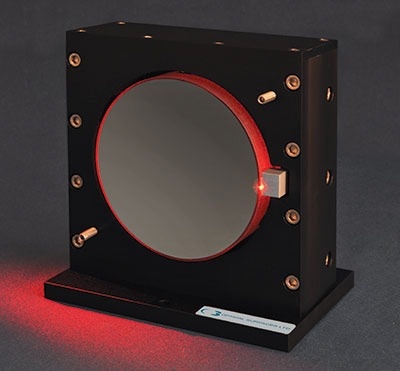Optical Surfaces Ltd. is a leading international manufacturer of large diameter, ultra-smooth off-axis parabolic mirrors for demanding applications.

Image Credit: Optical Surfaces Ltd.
Looking to develop their next generation of ultra-high resolution holographic diffraction gratings – Wasatch Photonics (Logan, Utah, USA) commissioned Optical Surfaces Ltd. to manufacture two large diameter off-axis parabolic mirrors – key components in their production process.
Widely used as optical components to separate light into its component wavelengths, Wasatch Photonics’ holographic diffraction gratings are key components in spectrometers, hyperspectral imaging systems, spectral-domain optical coherence tomography, and other photonics technologies. Holographic gratings are typically generated by imaging a series of closely spaced parallel lines into a light-sensitive material using an interferometric set-up. Producing holographic diffraction gratings of spectroscopic quality requires a stable optical bench and laser as well as the highest quality optical components (mirrors, collimating optics).
Dr. Aris Kouris, Sales Director at Optical Surfaces Ltd said, “In order to produce diffraction gratings using a holographic method, you need to produce a reference collimated beam at a relative angle to another collimated beam. The two collimated beams interact to produce an interference pattern, which is recorded on the holographic recording medium. If an ultra-high-resolution grating is required, it is important that the two beams are extremely well collimated with little wavefront error. However, another parameter that is also important is the slope error, which is a measure of the ‘smoothness’ achieved on the surface form. This quality parameter is critical to produce very high resolution, low noise gratings using the holographic method.”
He added, “Originally Wasatch Photonics contacted us to manufacture two 152 mm diameter off-axis parabolic mirrors to a high specification (better than Lambda/10 P-V at 633 nm) and we did so. These optical components were required as part of a test project to produce ultra-high resolution holographic gratings of 140 mm diameter. In early tests it became apparent that the Lambda/10 P-V surface accuracy alone was not sufficient to produce holographic gratings of sufficient quality. After consultation on the matter, we suggested that improving the slope errors on the mirrors might be beneficial. After Wasatch Photonics shipped back the two 152 mm diameter mirrors, we re-worked them to the improved slope error targets. The improved off-axis parabolic mirrors resulted in the customer being able to produce great quality ultra-high-resolution holographic gratings”.
Dr Kouris concluded, “As a result of this successful trial - Wasatch Photonics recently placed a follow-up order with Optical Surfaces Ltd. to produce two new 420 mm diameter off-axis parabolic mirrors of similar quality to enable them to produce even larger ultra-high resolution holographic gratings”.
These projects are an example of the collaborative development approach taken by Optical Surfaces in collaborating with key customers, a process which continues beyond delivery of the quoted product. According to Process Engineering Manager Andrew Clawson of Wasatch Photonics, “Validation of any component or tool that comes into our facility is an important part of our quality program and allows us to maintain high standards of quality from start to end of our manufacturing process. Working with a supplier like Optical Surfaces who shares our philosophy of ‘getting it right’ and continuous improvement makes this so much easier and gives us the confidence that we have the right partners to deliver on newer, bigger projects.”